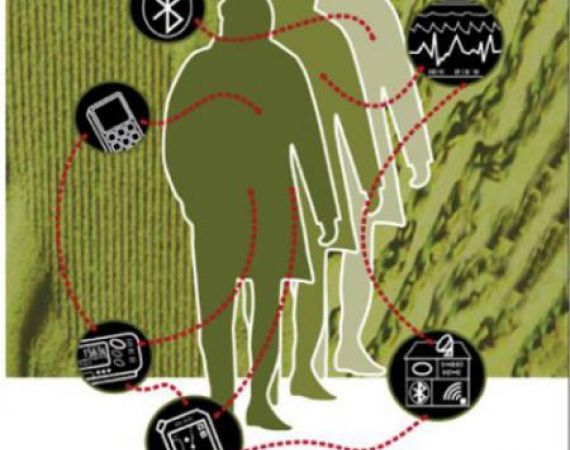Posted on Mon 21 Nov 2011
Lunchtime Talk: The Latest in Smart Clothes and Wearable Technology
Recently, Molly Price came to the Studio to give us a presentation on the latest developments in the field of Smart Clothes and Wearable Technology.

Smart Clothes and Wearable Technology
Recently, Molly Price came to the Studio to give us a presentation on the latest developments in the field of Smart Clothes and Wearable Technology.
Molly is currently working as a Research Associate at the Smart Clothes and Wearable Technology Research Centre (SCWTRC) at University of Wales, Newport (UWN), which she joined in 2010 to study and develop the applications of Smart Clothing: the use of new technologies and methods of production to enhance the functionality of textiles.
Molly has previously worked in Copenhagen with design company Diffus, developing their Interactive Sample Book (embedding sensors and LEDs into materials and exploring the use of memory alloys to produce morphing textiles), at Jason Bruges Studio, where she contributed to the creation of interactive installation Mimosa and at Lost Values, working on the LFLECT range of alternative reflective cycle wear.
Molly explained the ethos of the SCWTRC, whose work focuses on exploring and enhancing the functionality of Wearable Technology in everyday contexts to produce garments that are fit for purpose, rather than the gimmicky products that the field is popularly associated with. She told us that the Centre employs a development structure founded on multi-disciplinary research and co-design, drawing in experts from both academia and the clothing industry and embedding user-group trials into the process to engage with potential users of their products as much as possible.
In a brief overview of the history of Wearable Technology, Molly showed us how the field has developed since the 19th century, when a handheld light bulb represented the cutting edge of technology, through the 20th century with its bulky portable music and gaming gadgets, into the 21st century when devices such as mobile phones and MP3 players became much more discretely wearable. As an example of contemporary Wearable Technology, Molly showed us photos of people wearing a body paint called Bare Skin, which allows functioning electrical circuits to be painted onto human skin and connected to circuits on other surfaces by touch.
The talk then moved on to look at the various applications of Wearable Technologies, highlighting the key driving forces behind the production of Smart Clothing: extreme sports and the military. In both of these contexts, the use of technologically-enhanced garments can create clear functional performance advantages for the wearer, from body monitoring through to “second skin” clothing items that employ technical textiles and biomimicry to enhance aspects of performance.
Wearable Technologies also have applications in communications, controls for electronics, powering external devices (for example, Diffus’s Solar Handbag) and healthcare: helping to monitor patients in various ways or adjusting heating levels to keep people at appropriate temperatures.
Molly discussed the need for technology to be implemented throughout the process of garment creation, from the initial stages of design, right through to the disposal or recycling of the item, raising issues of sustainability and the need for developing industry environmental and ethical standards for these types of product. This forms another area of research for the SCWTRC and, as one answer to this problem, Molly suggested the idea of upcycling: allowing for the technology in Smart Clothes to be replaced or upgraded as technology advances.
The means of powering the technology within Smart Clothing can often present a problem, as objects such as batteries can be hard to integrate discretely into clothing, but potential solutions to this are being developed in the forms of flexible solar cells, printed batteries for low-power devices and piezoelectric devices.
In her recent work, Molly has been working with a number of research partners including the New Dynamics of Aging programme on a project exploring applications of wearable technology for the older generation, for which they have undertaken an intensive period of user-centred design with an over 50s walking group. The user group has directed the research towards body-responsive heated pads in clothing, locative media for navigation and the ability to contact friends or the emergency services in the event of an accident whilst hiking in remote locations. The sample group have been integral to developing the sorts of technologies that will result in a functional and desirable garment system for this emerging market.
The SCWTRC are also interested in exploring the commercial value of their work and have been collaborating with industry partners such as Fibretronic, who produce circuits that can be easily embedded into textiles. They also have two PhD students studying the potential of the Shimmer sensor: a small wireless sensor platform that can record and transmit physiological and kinematic data in real-time, which they are seeking to repackage so that it can be more comfortably integrated into garments.
Alongside this, they are looking into the way that users can interface with Wearable Technology, displaying feedback via flexible LCD screens or mobile phones and seeking the most suitable ways to convey this information to the intended consumer.
In closing, Molly spoke about the need for proper marketing strategies to be put in place in order to make consumers aware that Smart Clothes are not necessarily mere novelty items, but can be useful and potentially life-enhancing products.
If you would like to know more about Smart Clothes and Wearable Technology, Molly has suggested the following links:
SCWTRC
http://www.newport.ac.uk/research/researchcentres/researchcentres/scwtrc/Pages/default.aspx
Design for Ageing Well
http://www.newport.ac.uk/research/researchcentres/researchcentres/scwtrc/Pages/ADesignProcessfortheResearchandDevelopmentofSmartClotheswithEmbeddedTechnologieswithPotentialtoEnhanceQualityofLifeforOlder.aspx
New Dynamics of Aging
http://www.newdynamics.group.shef.ac.uk/design-for-ageing.html
General resource:
Crunch Wear
http://www.crunchwear.com/
Artists:
Diffus
http://www.diffus.dk/
DIY Wearable Technology:
How to get what you want
http://www.kobakant.at/DIY/
Fashioning Technology
http://www.fashioningtech.com/
Technology:
Prototyping
Lilypad Arduino
http://web.media.mit.edu/~leah/LilyPad/index.html
High Low Tech Group MIT
http://hlt.media.mit.edu/
Commercial
Fibretronic
http://fibretronic.com/
Shimmer
http://www.shimmer-research.com/